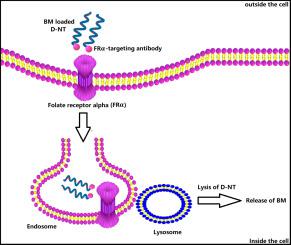Journal of Molecular Liquids ( IF 5.3 ) Pub Date : 2020-07-10 , DOI: 10.1016/j.molliq.2020.113785 Mirza Muhammad Faran Ashraf Baig , Wing-Fu Lai , Muhammad Furqan Akhtar , Ammara Saleem , Reyaj Mikrani , Muhammad Asim Farooq , Saud Asif Ahmed , Anum Tahir , Muhammad Naveed , Muhammad Abbas , Muhammad Tayyab Ansari

|
DNA-nanotechnology based on DNA scaffolding technique is an established approach to formulate water-miscible nano-structural frameworks. We have designed the hydrophilic DNA-nanotubes (D-NTs) as a (water-soluble) vehicle to encapsulate a water-insoluble DNA-intercalating anticancer drug. Bleomycin (BM) is a model hydrophobic anticancer drug used in this study capable to bind with the D-NTs to formulate BM loaded D-NTs. This BM@D-NTs system was evaluated for the improvement of the in vitro anti-cancer effects on the resistant prostate cancer xenograft CWR22R cells, over-expressed with the folate receptors/alpha (FRα). D-NTs were functionalized with the FRα-targeting antibodies to interact with the FRα (receptors) highly expressed on the resistant prostate cancer xenograft CWR22R cells. D-NTs not only increased the aqueous miscibility/dispersibility of BM but also enhanced the therapeutic efficiency as a targeted (site-specific) drug delivery system. D-NTs synthesis was achieved by sticky ends cohesions of DNA triangular tiles. DNA triangles were self-assembled from a freshly circularized short scaffold chain (84-NT) by annealing with the various staple strands. The polymerization of the triangular tiles gave rise to DNA-nanosheet lattices which underwent morphological transition guided by the twists in the DNA duplexes. This DNA double helix curvature caused self-coiling of the DNA 2D nano-sheets to condense into D-NTs morphology. Native-Page gel experiment showed decreased electrophoretic mobility down the gel confirming the successful execution of the polymerized lattices via sticky ends cohesion of the DNA-triangles. The final morphology and self-coiling of 2D DNA nano-sheets were confirmed through atomic force microscopy (AFM) showed the successful synthesis of D-NTs having diameter 3 to 5 μm and length 200 to 600 nm. BM was loaded onto D-NTs via incubation of hydro-alcoholic solution of the BM with the aqueous solution of D-NTs followed by the evaporation of alcohol and intercalation of the BM onto D-NTs. The intercalation of BM onto D-NTs was confirmed by UV-shift analysis. The targeted cytotoxicity of the BM@D-NTs for the CWR22R (resistant prostate cancer xenograft) cells was confirmed through MTT assay and the flow cytometry compared to the highly compatible empty D-NTs. Confocal microscopy revealed the time-dependent transfection of BM@D-NTs into CWR22R cells compared to the control cell line.
中文翻译:

靶向叶酸受体(α1)将博莱霉素加载的DNA纳米管内化到前列腺癌异种移植CWR22R细胞中
基于DNA支架技术的DNA纳米技术是制定与水混溶的纳米结构框架的既定方法。我们设计了亲水性DNA纳米管(D-NTs)作为(水溶性)载体,以包裹不溶于水的DNA嵌入抗癌药。博来霉素(BM)是本研究中使用的模型疏水抗癌药物,能够与D-NTs结合以配制载有BM的D-NTs。对该BM @ D-NTs系统进行了体外评估叶酸受体/α(FRα)过度表达对耐药前列腺癌异种移植CWR22R细胞的抗癌作用。D-NTs用靶向FRα的抗体进行功能化,以与在抗性前列腺癌异种移植CWR22R细胞上高度表达的FRα(受体)相互作用。D-NTs不仅增加了BM的水混溶性/分散性,而且还提高了其作为靶向(特定部位)药物递送系统的治疗效率。D-NTs的合成是通过DNA三角形瓷砖的粘性末端内聚实现的。DNA三角形是通过与各种短链退火从新鲜的圆形短支架链(84-NT)中自组装而成的。三角形瓦片的聚合产生了DNA-纳米片晶格,其经历了由DNA双链体的扭曲引导的形态学转变。这种DNA双螺旋曲率导致DNA 2D纳米片材自动卷曲,从而凝结为D-NTs形态。Native-Page凝胶实验表明,沿着凝胶向下的电泳迁移率降低,从而证实了聚合晶格的成功执行通过DNA三角形的粘性末端内聚。通过原子力显微镜(AFM)确认了2D DNA纳米片的最终形态和自卷曲,表明成功合成了直径3至5μm,长度200至600 nm的D-NT。BM通过以下方式加载到D-NT上将BM的水-醇溶液与D-NTs的水溶液一起温育,然后蒸发乙醇并将BM嵌入D-NTs上。通过UV-位移分析证实了BM插入到D-NT上。与高度兼容的空D-NTs相比,通过MTT测定和流式细胞术证实了BM @ D-NTs对CWR22R(耐药性前列腺癌异种移植)细胞的靶向细胞毒性。共聚焦显微镜显示与对照细胞系相比,BM @ D-NTs随时间的转染进入CWR22R细胞。











































 京公网安备 11010802027423号
京公网安备 11010802027423号